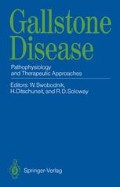Abstract
Therapeutic regimens in gallstone disease depend mainly on the composition of the stone. Most conservative approaches are restricted to cholesterol concrements. Systemic litholysis using chenodeoxycholic and ursodeoxycholic acids [1–3] and extracorporeal shock-wave lithotripsy (ESWL; [4, 5]) exhibit high success rates only in cases of small and (in ESWL) preferably single cholesterol stones. Local litholysis, which was performed initially in cholesterol stone disease with ether preparations [6], is the only non-operative therapy which can also be applied in pigment stone disease, provided the proper solvents are used. Furthermore, stone size and stone number do not play a role in the selection of patients for this form of treatment [7, 8]. In complicated gallstone disease, for example, cholecystitis and gallstone ileus, cholecystectomy has been the preferred form of therapy since its introduction in 1882 by Langenbuch [9]. An operative procedure must also be performed in end-stage gallstone disease, especially when the lack of a lumen in chronic cholecystitis prohibits percutaneous puncture. Cholecystectomy is also the procedure of choice in patients with a chronically inflamed, thickened gallbladder wall due the motility defect which would inevitably lead to stone recurrence after successful conservative treatment. A conservative approach in symptomatic but uncomplicated gallstone patients with calcified pigment gallbladder stones is lacking. The development of an alternate technique for local litholysis of this type of stone is demonstrated in this chapter.
Access this chapter
Tax calculation will be finalised at checkout
Purchases are for personal use only
Preview
Unable to display preview. Download preview PDF.
References
Danzinger RG, Hoffmann AF, Schoenfield LJ, Thistle JL (1972) Dissolution of cholesterol gallstones by chenodeoxycholic acid. N Engl J Med 286: 1–8
Nakagawa S, Makino J, Ishizaki T, Dohi L (1977) Dissolution of cholesterol gallstones by ursodeoxycholic acid. Lancet 11: 367–369
Podda M, Zuin M, Battezzatti M, Ghezzi C, deFazio D, Dioguardi ML (1989) Efficacy and safety of a combination of chenodeoxycholic acid and ursodeoxycholic acid for gallstone dissolution: a comparison with ursodeoxycholic acid alone. Gastroenterology 96: 222–229
Sauerbruch T, Delius M, Paumgartner G, Holl J, Wess O, Weber W, Hepp W, Brendel W (1986) Fragmentation of gallstones by extracorporeal shock waves. N Engl J Med 314: 818–822
Sackmann M, Delius M, Sauerbruch T, Holl J, Weber W, Ippisch E, Hagelhauer Y, Wess O, Hepp W, Brendel W, Paumgartner G (1988) Shock-wave lithotripsy of gallbladder stones. N Engl J Med 318: 393–397
Allen MJ, Borody TJ, Bugliosi TF, May GR, LaRusso NF, Thistle JL (1985) Cholelitholysis using methyl tertiary butyl ether. Gastroenterology 88: 122–125
Thistle JL, May GR, Bender CE, Williams HJ, LeRoy AJ, Nelson PE, Peine CJ, Petersen BT, McCollough JE (1989) Dissolution of cholesterol gallbladder stones by methyl tert-butyl ether administered by percutaneous transhepatic catheter. N Engl J Med 320: 633–639
Hellstern A, Leuschner V, Fischer H, Leuschner M, Caspary W (1988) Percutan-transhepatische Lyse von Gallenblasensteinen mit Methyl-Tert-Butyl Ether. Dtsch Med Wochenschr 113: 506–510
Langenbuch C (1882) Ein Fall von Exstirpation der Gallenblase wegen chronischer Cholelithiasis: Heilung. Berl Klin Wochenschr 19: 725–727
Walker JW (1891) The removal of gallstones. Lancet 1: 874–879
Best RR, Rasmusen JA, Wilson CE (1953) An evaluation of solutions for fragmentation and dissolution of gallstones and their effect on liver and ductal tissue. Ann Surg 138: 570–577
Gardner B, Dennis CR, Patti J (1975) Current status of heparin dissolution of gallstones. Am J Surg 130: 293–299
Way LW, Motson RW (1976) Dissolution of retained common duct stones. Advanc Surg 10: 99–103
Thistle JL, Carlson GL, Hoffmann AR, LaRusso NF, McCarthy RL, Flynn GL, Higuchi WJ, Bubayan VK (1980) Monooctanoin, a dissolution agent for retained cholesterol gallstones: physical properties and clinical application. Gastroenterology 68: 1016–1020
Mok HYI, Bell GD, Whitney B, Dowling RH (1974) Stones in common bile duct: non operative management. Proc Roy Soc Med 67: 658–666
Wosiewitz V, Schenk J, Sabinski T, Schmack B (1983) Investigation on common bile duct stones. Digestion 26: 43–47
Leuschner U, Wurbs D, Baumgärtel H, Helm EB, Classen M (1981) Alternating treatment of common bile duct stones with a modified GMOC and BA-EDTA solution by nasobiliary tube. Scand J Gastroenterol 16: 497–503
Swobodnik W, Wechsler JG, Klüppelberg U, Wenzel H, Faulhaber JD, Junge U, Ditschuneit H (1984) Auflösung von Rezidivsteinen im Choledochus durch modifizierte Spülbehandlung über eine nasobiliäre Verweilsonde. Dtsch med Wochenschr 109: 1232–1236
Allen MJ, Borody TJ, Bugliosi TG, May GR, LaRusso NF, Thistle JL (1985) Rapid dissolution of gallstones by methyl tert-butyl ether. N Engl J Med 312: 217–220
Sutor BJ, Wooley SE (1971) A statistical survey of the composition of gallstones in eight countries. Gut 12: 55 - 64
Nakayama F (1968) Quantitative microanalysis of gallstones. J Lab Clin Med 72: 602–611
Carey MC (1978) Critical tables for calculating the cholesterol saturation of native bile. J Lipid Res 19: 945–955
Swobodnik W, Klüppelberg U, Wechsler JG, Volz M, Normandin G, Ditschuneit H (1985) Rapid and accurate reversed-phase high performance liquid chromatographic determination of conjugated bile acids in human bile for routine clinical applications. J Chromatogr 339: 263–271
Author information
Authors and Affiliations
Editor information
Editors and Affiliations
Rights and permissions
Copyright information
© 1990 Springer-Verlag, Berlin Heidelberg
About this paper
Cite this paper
Swobodnik, W. (1990). Local Litholysis of Calcified Pigment Stones. In: Swobodnik, W., Soloway, R.D., Ditschuneit, H. (eds) Gallstone Disease. Springer, Berlin, Heidelberg. https://doi.org/10.1007/978-3-642-74619-2_25
Download citation
DOI: https://doi.org/10.1007/978-3-642-74619-2_25
Publisher Name: Springer, Berlin, Heidelberg
Print ISBN: 978-3-540-50965-3
Online ISBN: 978-3-642-74619-2
eBook Packages: Springer Book Archive

